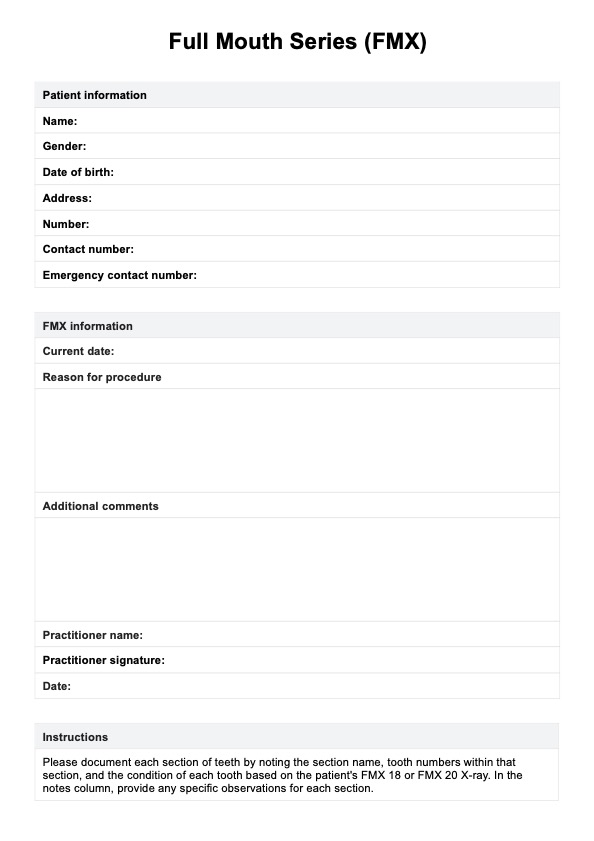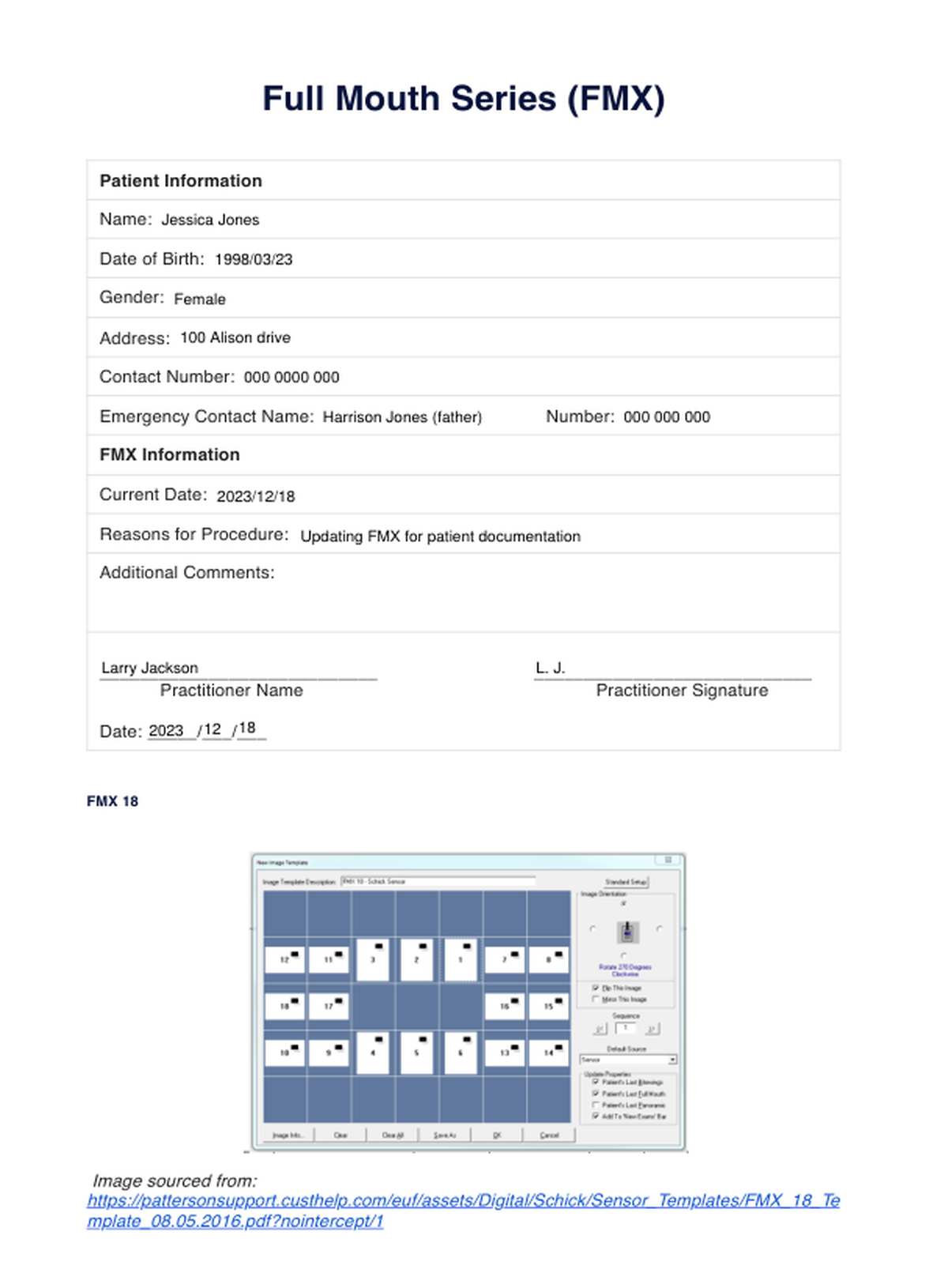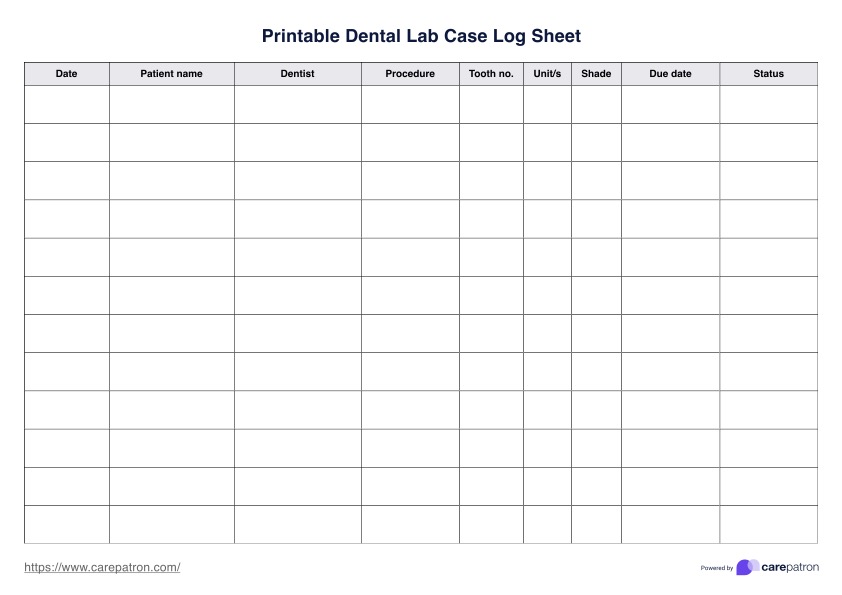Full Mouth Series Template
Organize your oral health documentation by using our full mouth series template! The template structures all necessary information for optimal patient records.


What is a Full Mouth Series Template?
A full mouth series (FMX) test is a screening procedure used by health practitioners, such as dentists and oral health practitioners, to produce an X-ray of a patient’s full mouth (Blackhart, 2016/2018). These are most typically conducted every five years to assess oral health, or recommended by an oral health specialist as a screening procedure.
The procedure itself places intraoral film inside the patient’s mouth to generate an image of the teeth and other structures, helping support tooth and gum health. For adults, the test typically results in a series of 18 to 20 X-ray images, showing all bitewings and periapical (PA) radiographs of every tooth from the root to the crown (Blackhart, 2016/18).
Generating an FMX assesses the entire mouth and can help diagnose tumors or lesions that are not visible externally. Being a full-mouth image, it also allows for the diagnosis of multiple teeth at once, optimizing time and resources (Kreitzberg, 2005).
However, given the large amount of information generated using this screen, it can be challenging to document the findings in an organized and informative way. This is where an FMX template becomes an invaluable resource.
An FMX template is a resource designed to organize diagnoses and information for each tooth. With a user-friendly table and corresponding diagram, the template effectively contains information that can be used for diagnoses or kept as a document for future use.
This makes it an invaluable diagnostic resource or can be used as a baseline of oral health to measure any future abnormalities.
Using our FMX template, specialist oral health practitioners can efficiently complete and document results. This can save valuable time and resources, allowing them to focus on providing the optimal patient experience.
Full Mouth Series Template
Full Mouth Series Template Example
How does it work?
A full mouth series (FMX) template structures the information gained from the x-ray images of each tooth, allowing practitioners to document tooth names, placement, and any additional information essential for diagnosis. To show you how the template works, we have broken down the process into the following steps:
Step 1: Obtain the template
Begin by accessing the template. Depending on your preferences, this can be done by using an electronic version to file on your practice management software or downloading a physical copy using the following link:
Download the Printable Full Mouth Series Template here.
Step 2: FMX referral
Patients who are experiencing any issues that are not visible on the surface or require an updated scan of their full mouth should be referred for an FMX. Completing this scan may uncover any underlying health issues or be used as a baseline for oral health to assess any future deviations.
Step 3: Completing an FMX
Using intraoral film, generate FMX images of each tooth. Depending on the number of teeth, this may produce 18 to 20 X-ray images focusing on one tooth from root to crown. The procedure is typically completed by a general dentist, who observes any severe bone loss or other issues. These images are then sent to a specialist oral health practitioner, such as a periodontist, for further investigation
Step 4: Use the template to analyze information
Specialists can document information by comparing the X-ray images to the placement image on the template. Within this step, record the names, numbers, and information about teeth in the sections relative to the image on the template, documenting these in the corresponding template section.
Step 5: Consultation
Following analysis, specialists should then consult the patient’s dentist to discuss any findings or diagnoses. These can then inform patient consultations, followed by treatment planning and administration.
When would you use this template?
The full mouth series (FMX) template is primarily designed for oral health specialists, such as periodontists, to structure their patient records following an FMX procedure. The following are some scenarios in which this template would be beneficial in practice:
Assessment of multiple teeth
Patients experiencing multiple issues regarding oral health or requiring appraisal of multiple teeth at once may require an FMX. The template can then organize information from the radiographs and record any of their findings. This may include tooth placement, developmental abnormalities, impacted teeth, periodontium status, or decay.
Oral health consultation
In simplifying the presentation of FMX information, the template can be used as a discussion point between the specialist practitioners and the general dentist to then inform treatments. Furthermore, the template may also be used in consultations with patients to discuss their results and the treatments recommended.
Initial visit
It is part of regular practice for a patient to acquire an FMX during their first visit to their dentist. The template can be used as an initial patient document, which can be used to compare any future screens for diagnoses. Furthermore, the template can be replicated into the same file, allowing practitioners to keep one comprehensive document displaying the status of growth or oral development.
Updating documentation
The template can be replicated into the same file, allowing practitioners to keep one comprehensive document displaying the status of growth or oral development. Patients with good oral health are usually recommended to complete an FMX every 5 years, while patients at higher risks of developmental issues or abnormalities are typically recommended to get one every 3 years.
What do the results mean?
Results using our free full mouth series template are multi-faceted and may differ among patients in accordance with several individual factors. These may include the patient’s oral health history, development status, previous procedures, reasons for FMX, and oral structures. However, here are some common results one can expect and what they may mean for the patient:
Good oral health
For some patients, the FMX may demonstrate good oral health and normal development. These patients are typically instructed to continue their current oral health regimes with one annual oral health check-up. This result is most usually seen in patients referred for an FMX to update their records or join a new oral health clinic.
Bone loss
An FMX template may identify loss of bone or supportive structures. In this instance, the specialist would discuss these results with the patient’s general dentist before beginning to plan treatment.
Abnormal development
Patients younger and still in developing stages may show abnormal development of teeth, bone, or supportive structures during their FMX. With this result, specialists would usually discuss this with the patient’s general dentists to investigate whether these abnormalities may pose risks in the future. Any treatment procedures would then be discussed in consultation with the patient and their caregivers.
Benefits of a functional mouth series
Using our template in accordance with a full mouth series screening can be beneficial for a multitude of reasons surrounding patient health status and enhanced practice. The following outlines some of the benefits for patients and oral health practitioners:
Early diagnosis
As one of the very few imaging techniques available for tumor or lesion diagnosis, a functional mouth series is essential for preventative screening for patients at risk.
For patients with underlying oral abnormalities, the screen can provide a diagnosis at the initial stages which can inform early interventions. This can save patients from bone loss and may help any further progressions for improved oral health outcomes.
Time efficient
Given that this imaging generates radiographic imagery for all teeth and supportive structures at once, this technique is incredibly time-effective. Additionally, using the full mouth series template can optimize time and clinical documentation, allowing practitioners to focus more time and resources on patient care.
Preventative screening
The full mouth series can provide insight at early stages because many oral health issues stem from underlying issues that are not visible to the eye. In particular, the screen can identify whether patients are at risk of developing issues from things like impacted or malformed teeth. With this information, practitioners may recommend ongoing oral health checkups or more regular full-mouth series as a way of preventative screening.
References
Blackhart, S. (2016). Digital X-Rays. Blackhart Dentistry. https://www.oakdalefamilydentalcare.com/xrays#:~:text=Full%20Mouth%20Series%20(FMX),teeth%20with%20problems%20to%20diagnose.
Kreitzberg, G. R. (2005). The Full Mouth Series. New York State Dental Journal; Hempstead, 71(4), 12-3. https://www.proquest.com/docview/213352251/citation/91BABBF2EEF451BPQ/1?accountid=8424
Nejad, M. (2015). Preventative Dentistry. Helm, Nejad & Stanley Dentistry. https://www.beverlyhillsladentist.com/blog/how-often-should-you-get-dental-x-rays/#:~:text=As%20a%20general%20rule%20of,diagnose%20what%20is%20going%20on.
NEMA (n.d.). OO Structured Display (Informative). NEMA. https://dicom.nema.org/medical/Dicom/2014c/output/chtml/part17/chapter_OO.html
Commonly asked questions
A full mouth series template can be created by simply accessing our full mouth series template PDF. By structuring all of the necessary information, the template allows practitioners to produce one comprehensive document that can be used for clinical documentation or consultation.
The template is primarily designed as documentation for any findings or diagnoses arising from a full mouth series. This document can then be used to inform any treatments or consultations to enhance patient oral health.
The full mouth series template is used to structure information from the screening, allowing practitioners to organize all necessary information in one comprehensive document.
A specialist oral health practitioner, such as a periodontist most typically create a full mouth series template.











































































































